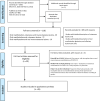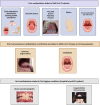Oro-facial mucocutaneous manifestations of Coronavirus Disease-2019 (COVID-19): A systematic review
- PMID: 35648785
- PMCID: PMC9159624
- DOI: 10.1371/journal.pone.0265531
Oro-facial mucocutaneous manifestations of Coronavirus Disease-2019 (COVID-19): A systematic review
Abstract
We reviewed the prevalence, the likely aetiopathogenesis, and the management of oro-facial mucocutaneous manifestations of Coronavirus Disease-2019 (COVID-19), caused by the Severe Acute Respiratory Syndrome Coronavirus -2 (SARS-CoV-2). English language manuscripts searched using standard databases yielded 26 articles that met the inclusion criteria. In total, 169 cases (75 females; 94 males) from 15 countries with a spectrum of COVID-19 severities were reviewed. Gustatory perturbations were prevalent in over 70%. Mucocutaneous manifestations were reported predominantly on the tongue, palate, buccal mucosa, gingivae, and lips and included ulcers, blisters, erosions, papillary hyperplasia, macules, glossitis, and mucositis. Ulcerative lesions, present in over 50 percent, were the most common oral manifestation. Lesions resembling candidal infections, with burning mouth, were prevalent in 19%. Petechiae and angina bullosa were generally seen, subsequent to COVID-19 therapies, in 11%. Ulcerated, necrotic gingivae were documented in severely ill with poor oral hygiene. These manifestations, present across the COVID-19 disease spectrum, were commonly associated with the immunosuppressed state and/ or the concurrent antimicrobial/steroidal therapies. In summary, a wide variety of orofacial mucocutaneous lesions manifest in COVID-19. They are likely to be secondary to the disease-associated immune impairment and/or pharmaco-therapy rather than a direct result of SARS-CoV-2 infection per se.
Conflict of interest statement
The authors have declared that no competing interests exist.
Figures
Comment in
-
Oral and genital mucosa lesions in patients with COVID-19: a multicentric case series.Int J Dermatol. 2023 Oct;62(10):e554-e556. doi: 10.1111/ijd.16685. Epub 2023 Apr 17. Int J Dermatol. 2023. PMID: 37063087 No abstract available.
Similar articles
-
The spectrum of non-characteristic oral manifestations in COVID-19 - a scoping brief commentary.Med Pr. 2021 Dec 22;72(6):685-692. doi: 10.13075/mp.5893.01135. Epub 2021 Sep 16. Med Pr. 2021. PMID: 34596170
-
An integrative review of oral manifestations in patients with COVID-19: signs directly related to SARS-CoV-2 infection or secondary findings?Int J Dermatol. 2022 Mar;61(3):278-290. doi: 10.1111/ijd.15881. Epub 2021 Sep 19. Int J Dermatol. 2022. PMID: 34541674 Free PMC article. Review.
-
An update on oral clinical courses among patients with severe acute respiratory syndrome coronavirus 2 (SARS-CoV-2) infection: A clinical follow-up (a prospective prevalent cohort) study.PLoS One. 2022 Oct 21;17(10):e0275817. doi: 10.1371/journal.pone.0275817. eCollection 2022. PLoS One. 2022. PMID: 36269692 Free PMC article.
-
Oral Manifestations in Patients with COVID-19: A Living Systematic Review.J Dent Res. 2021 Feb;100(2):141-154. doi: 10.1177/0022034520957289. Epub 2020 Sep 11. J Dent Res. 2021. PMID: 32914677
-
Oral manifestations of COVID-19 disease: A review article.Dermatol Ther. 2021 Jan;34(1):e14578. doi: 10.1111/dth.14578. Epub 2020 Dec 13. Dermatol Ther. 2021. PMID: 33236823 Free PMC article. Review.
Cited by
-
Challenges of Diagnosis and Management of Burning Mouth Syndrome: A Literature Review.Curr Aging Sci. 2025;18(2):102-119. doi: 10.2174/0118746098279205240812113353. Curr Aging Sci. 2025. PMID: 40289359 Review.
-
A reflection on COVID-19 and oral mucosal lesion: a systematic review.Front Oral Health. 2023 Dec 18;4:1322458. doi: 10.3389/froh.2023.1322458. eCollection 2023. Front Oral Health. 2023. PMID: 38169876 Free PMC article. Review.
-
The Oral Lesion in the COVID-19 Patient: Is It True Oral Manifestation or Not?Infect Drug Resist. 2023 Jul 4;16:4357-4385. doi: 10.2147/IDR.S411615. eCollection 2023. Infect Drug Resist. 2023. PMID: 37424667 Free PMC article. Review.
-
Microbial Dynamics in COVID-19: Unraveling the Impact of Human Microbiome on Disease Susceptibility and Therapeutic Strategies.Curr Microbiol. 2024 Dec 25;82(1):59. doi: 10.1007/s00284-024-04041-9. Curr Microbiol. 2024. PMID: 39720963 Review.
-
Post-acute infection syndrome after COVID-19: effects on the oral and maxillofacial region and the recent publication trends.J Korean Assoc Oral Maxillofac Surg. 2022 Jun 30;48(3):131-132. doi: 10.5125/jkaoms.2022.48.3.131. J Korean Assoc Oral Maxillofac Surg. 2022. PMID: 35770353 Free PMC article. No abstract available.
References
-
- Hamming I, Timens W, Bulthuis M, Lely A, Navis Gv, van Goor H. Tissue distribution of ACE2 protein, the functional receptor for SARS coronavirus. A first step in understanding SARS pathogenesis. The Journal of Pathology: A Journal of the Pathological Society of Great Britain and Ireland. 2004;203(2):631–7. doi: 10.1002/path.1570 - DOI - PMC - PubMed
-
- Zou X, Chen K, Zou J, Han P, Hao J, Han Z. Single-cell RNA-seq data analysis on the receptor ACE2 expression reveals the potential risk of different human organs vulnerable to 2019-nCoV infection. Front Med. 2020;14(2):185–92. Epub 2020/03/15. doi: 10.1007/s11684-020-0754-0 ; PubMed Central PMCID: PMC7088738. - DOI - PMC - PubMed
Publication types
MeSH terms
LinkOut - more resources
Full Text Sources
Medical
Miscellaneous



